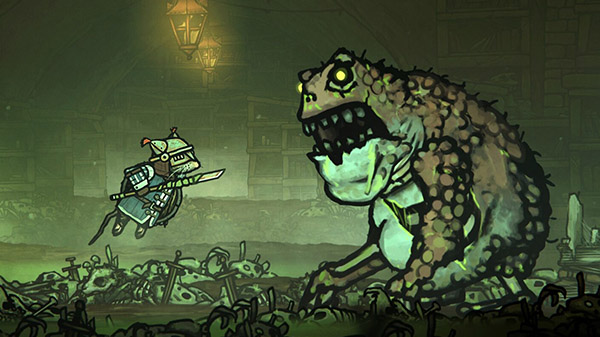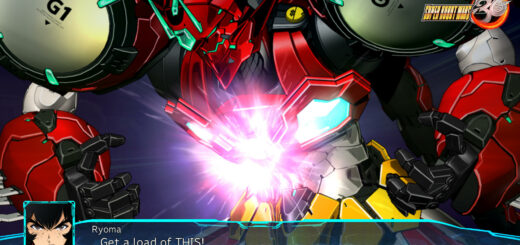Tails of Iron Review
Redgi-cide
When trying to come up with some useful comparisons to help explain the ideas behind developer Odd Bug Studios’ action RPG Tails of Iron, it’s hard to immediately think of another game quite like it. While it shares some DNA with the likes of Team Cherry’s 2017 release Hollow Knight as well as some of the more recent 2D Metroid titles, it feels like its own beast a good portion of the time. This is by no means a bad thing, as the game delivers a well-crafted romp through a fairy-tale kingdom of rats, frogs, and other critters while offering engaging and challenging combat to boot.
Tails of Iron takes place in the enchanting kingdom of the rats, whose king established an era of peace for his kingdom after successfully driving back a race of brutal and blood-thirsty frog invaders. With the king now advanced in years, it falls to his sons to compete with one another in trial by combat to determine the king’s rightful successor. Players take on the role of Prince Redgi, the youngest and most diminutive of the king’s sons to challenge his kin for the crown. However, upon Redgi winning the contest, disaster strikes the kingdom as the evil frogs disrupt the proceedings, killing the old king and putting the kingdom to the torch. It falls to Redgi to live up to his recently inherited duties and avenge his royal father, rescue his subjects, and set the kingdom back on a path to peace and prosperity.
The frogs are a bloodthirsty race, so besting them will require Redgi to master various combat skills. Players have access to the fairly standard loadout of light, heavy, and ranged attack options, each with different weapons that can be equipped. More importantly than Redgi’s attack options, however, are his enemies’ battle tactics. Players will need to quickly respond to imminent attacks in one of several ways or be caught unawares and sustain heavy damage. Redgi can easily block or dodge normal enemy attacks (provided he’s facing the right way), but enemies’ special combat skills are a different matter. As an enemy winds up for one of these, a color-coded on-screen warning icon cues players in to what’s coming. For example, a yellow warning symbol indicates that the upcoming attack can be parried, breaking the enemy’s defense momentarily and opening them up for some free counter-damage. On the other hand, a red attack can’t be blocked or parried, and so must be evaded with a well-timed dodge. It’s a fairly simple system that nonetheless requires a careful dance of attacks, blocks, dodges, and parries to be mastered. Being a far more personal tête-à-tête, combat rarely goes beyond one-on-one or one-on-two skirmishes, though slaying a foe may cause another to run in to take their place.
Where players are well and truly tested, however, are the boss fights. Bosses tend to be large, with unique designs and varied movesets that are as fun to learn and get used to as they are challenging to deal with. Bosses test Redgi with many one-off abilities and may fly, burrow under the ground, crawl along the ceiling, or perform dodge and parry moves with a much greater reach than the game’s garden-variety foes. Some even come in pairs or with additional enemies to complicate things. At the time of writing, Tails of Iron includes the free Bloody Whiskers DLC, which adds a secret boss and a combat arena, greatly upping the level of late-game challenge available to players who have mastered the already considerable difficulty of the base game.
Though challenging, exploring the far reaches of Redgi’s kingdom consistently offers new and enchanting sights to uncover. The side-scrolled world looks great, with beautiful, hand-drawn artwork on display and multiple fore- and background layers melding together. While the game is often dark, particularly due to a large amount of underground areas like sewers or mines, it’s never drab, and indoor spaces are lavishly depicted. The map isn’t as large as other games of this type, but in a nice touch the map, too, features environmental details as Redgi’s exploration fills more and more of it in. Redgi will be unable to access every nook and cranny until additional items are discovered, like a gas mask to traverse sections shrouded by poison mist. Sidequests are, unfortunately, less enchanting, being few in number and fairly shallow, though a fast-travel system at least makes backtracking to them more tolerable.
Though Tails of Iron is a fairy tale at heart, it’s a far cry from the lighter, Disney-esque norm often seen; its somber and brooding aesthetic ultimately create a mature and detailed world that just so happens to be populated by animals. It’s brutal and violent, without being gory or over-the-top; for example, Redgi is able to heal himself by drinking freshly squeezed bug juice, which is every bit as messy to harvest from insect carcasses as it sounds. The most intense pops of color come from the bright yellow blood that is spilled in combat, accompanying wet squelching sounds, spraying through the air, and coating enemies as Redgi’s weapon hacks away at them.
The game’s audio design also mirrors its dark fairy tale atmosphere. Some areas, particularly early on before tragedy strikes the kingdom, feature jaunty and upbeat medieval music, while the lion’s share of areas are steeped in atmospheric ambient noise. Since the areas include places like musty crypts and cavernous sewers, the audio design is suitably foreboding. The game’s lone speaking role, however, will be instantly familiar to many RPGamers, as the game is narrated by the unmistakable Geralt of Rivia himself, Doug Cockle. This is more than merely a name to flaunt for the game’s marketing, as Cockle’s narrator jumps in quite often, lending some welcome flavor and world-building. Less pleasant are the actual character “voices”; everytime someone needs to communicate with Redgi, players must endure a sequence of staccato tones that resemble a wooden recorder stuck in someone’s wind pipe spewing a sequence of discordant notes at them.
Ultimately, Tails of Iron is a pleasant surprise. The game’s darker tone and not inconsiderable challenge made it a far more engaging title than its “Animal Kingdom” plot might at first brush suggest. While exploration is fun enough, it’s the combat system that is the real standout here, simple enough to be quickly learned but intricate enough to provide plenty of variety, particularly during the fun boss fights. With fine presentation values to boot, it’s an enjoyable overall package that’s easy to recommend.


Engaging combat system keeps you on your toes without being complicated
Excellent graphical presentation without sacrificing darker tone
Geralt of Rivia narrates your adventure!
Sidequests would benefit from more depth
Painful dialog sound effects mean characters would have been better off left mute









Recent Comments